As the future of educational spaces takes shape, Lionakis designers and architects are working to understand the importance of NextGen learning solutions and how to implement them in classrooms. As part of Santa Monica-Malibu Unified School District (SMMUSD)’s NextGen Furniture Standards Project, Lionakis field tested over 500 pieces of furniture throughout four campuses over the course of three months.
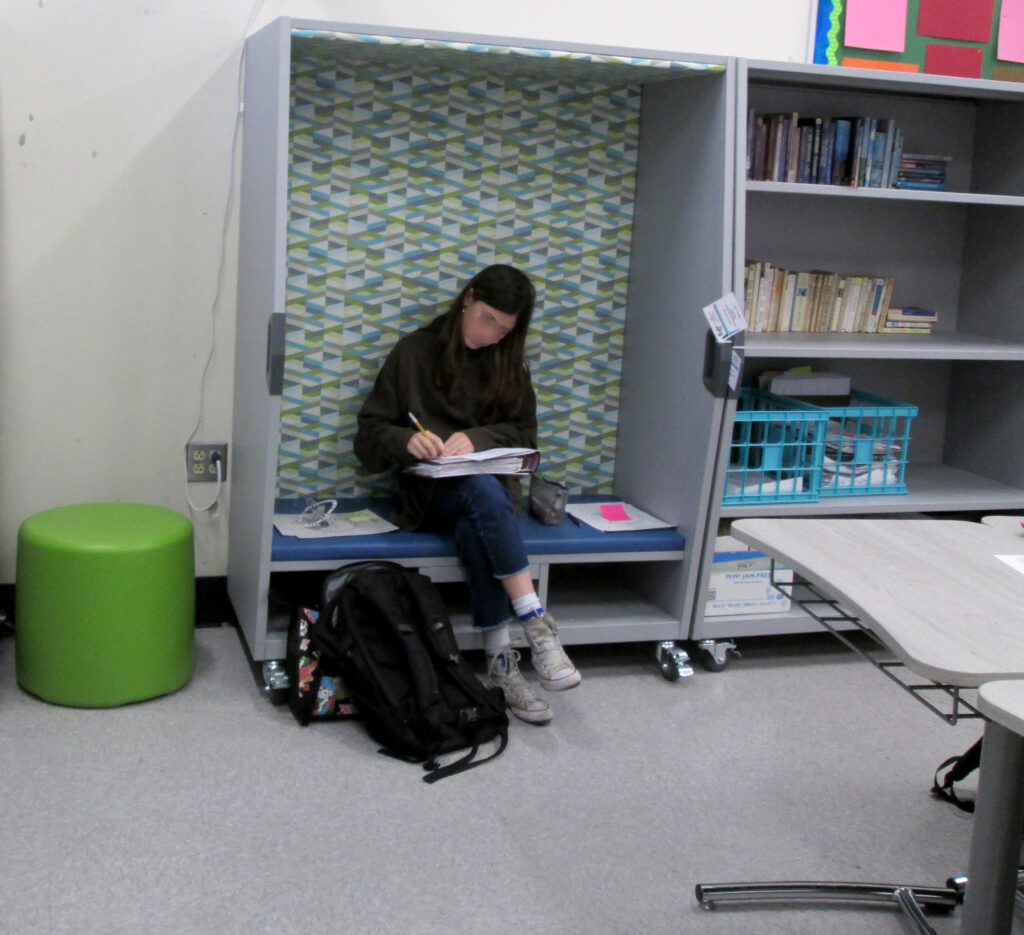
As part of SMMUSD’s Educational Specifications (Ed Spec), implementing these furniture solutions allows them to take great strides toward their goal of a technology-driven and project-based learning approach. Their Ed Spec clarifies that using a project-based learning approach through NextGen technology will “utilize real-world problem solving as a way for students to assimilate information and develop creative solutions.”
Initially thought to be a welcome change to prepare students for their futures in a collaborative way, this implementation had mixed reception from both teachers and students. Many teachers within SMMUSD struggled to find an effective way to implement the new furniture solutions into their classrooms, resulting in a disappointingly negative response to surveys. However, upon further inspection of this data, our team realized that the negative responses directly correlated with a lack of NextGen usage in their classrooms.
These NextGen classrooms encourage meaningful relationships between teachers and students, which helps students develop strong communication and interpersonal skills.
How can we support the new Ed Spec goals?
As outlined in the district’s Ed Spec, they wanted to implement zoned and flexible classrooms, which are dedicated to an interactive project-based learning approach. This approach gives students the freedom to work collaboratively or individually, and provides them with tools to develop problem-solving skills, critical thinking abilities, and social skills. Additionally, these NextGen classrooms encourage meaningful relationships between teachers and students, which helps students develop strong communication and interpersonal skills.
NextGen furniture solutions allow teachers the freedom to design their lesson plans in a hands-on way. Soft, moveable seating with durable fabric makes it easier for students to work on group projects. Students are also able to use different desks for both group and individual projects, which gives them the freedom to work to their strengths and be more productive.
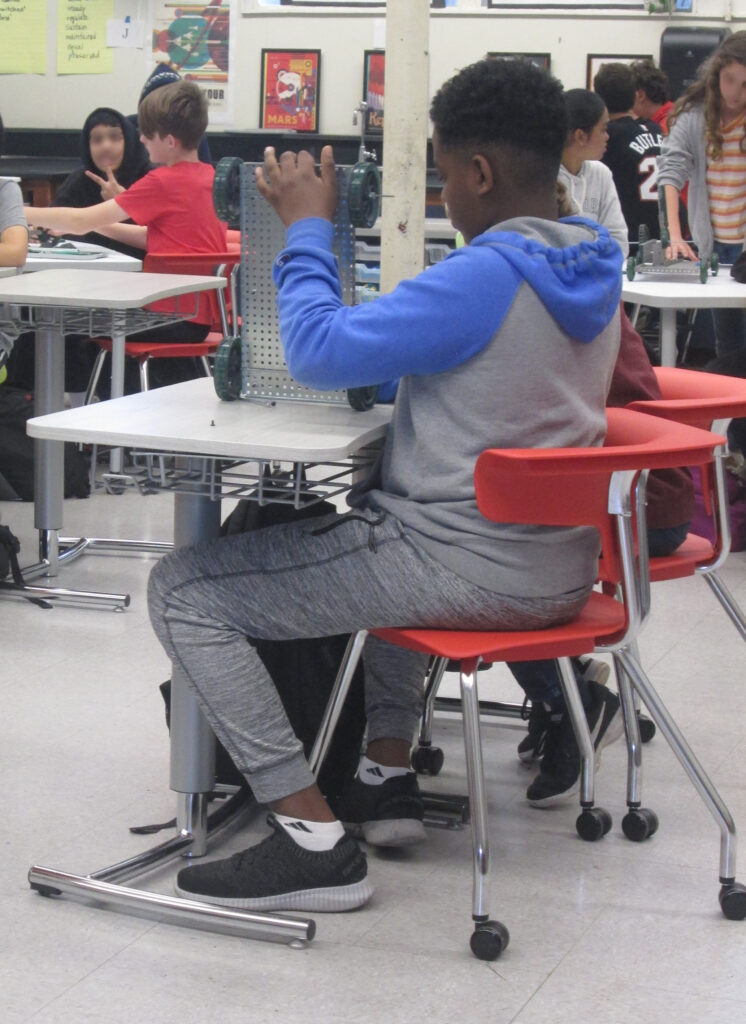
Pre-pilot survey & goals for the project
SMMUSD’s goal was to boost engagement by bringing engaging and flexible furniture to the classroom and craft a learning environment that would be deeply nourishing and beneficial to all students. Lionakis’ team worked with SMMUSD teachers on a series of workshops to determine what would help them achieve their Ed Spec goals. Ultimately, Lionakis and SMMUSD pioneered this project to build an environment that ensures students are well-prepared and well-qualified to compete for 21st century jobs, with an emphasis on critical thinking and innovation.
During these workshops, SMMUSD and Lionakis intended to use this project to decide what the most successful furniture combinations could be for their classrooms. For the pilot, the district used four types of furniture combinations in classrooms: flexible seating, soft seating, student desking, and specialty items. Student seating included two options: standard chairs casters and storage racks, and “wiggle” stools made of solid plastic. Sixth, seventh, and eighth grades had an extra option for seating, a high stool with a back for lab spaces and high top tables. Soft seating options included a single or mid-sized seat for students to move around the classroom, or a “think nook” — an enclosed type of seating for individual study time. Student desking included mobile single sit-to-stand desks, or group desks for collaborative projects. Finally, specialty items included mobile teacher desk/podium combination units, and mobile maker tables for students with built-in storage. In place of the maker tables, students in kindergarten to second grade were offered individual cubby storage units.
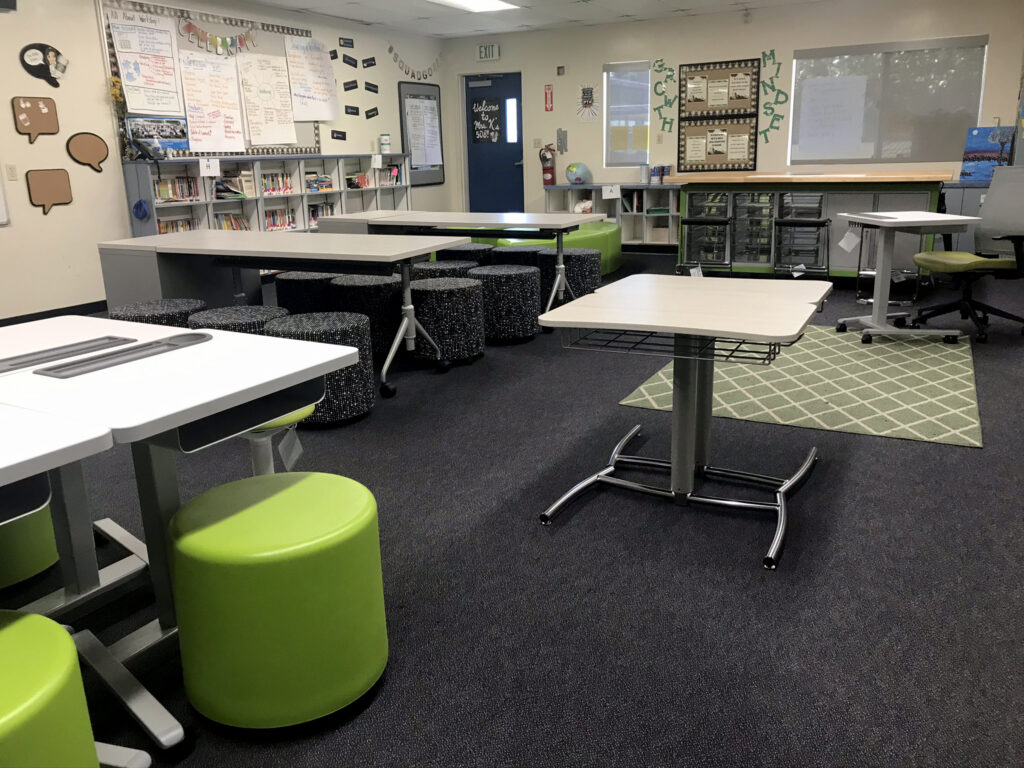
In a pre-pilot survey, students were asked questions about how they wanted to engage with learning. 67% of students answered “yes” to the question, “Would you like to work in groups more?”, and 87% of students expressed interest in being allowed to pick where they sat in the classroom to do their work. These results greatly helped architects and pushed their efforts in a way that might be more beneficial for students.
Teachers were also asked several questions in a pre-pilot survey, with over 42% of teachers being “very concerned” about mobile furniture being a distraction for their students. However, a third of these same teachers had agreed that flexible/mobile furniture makes a huge impact on their students and provides a wider range of classroom activities. Incorporating new teaching modalities into the classroom could be risky, but NextGen’s furniture solutions provide a positive impact to both teachers and students.
Mid-pilot survey results
During the mid-pilot survey, teachers saw very positive results in key areas. A majority of these teachers had responded that the pilot furniture provided a wider range of classroom activities, as well as provided students more opportunities to work in groups. With these results, teachers were optimistic that the pilot test was going to be successful for their curriculum going forward, as well as help achieve the district’s Ed Spec goals.
Students had a very positive response to the new furniture and learning styles. Out of 650 students, 87% of them responded that they liked having different types of furniture, while 73% said that they felt they were able to work better in groups. Clearly, the change was received positively by students, as 93% of the students had stated that they would like this new classroom style to be permanent.

Post-Installation results
Two years after the NextGen Furniture Standards Project, SMMUSD decided to install flexible and collaborative furniture district-wide, over 10 campuses. Results in post-installation surveys, however, were initially shocking to the team.
Out of 190 students, the initial positivity and optimism discovered during the mid-pilot survey had dwindled. 70% of students claimed that they had worked in groups about the same amount as before the furniture was installed, and only 51% of students reported that they liked the new furniture in the classroom.
The most surprising results of all came from teachers during the post-installation survey. Teachers were asked questions such as, “Do you think the furniture helps achieve the district’s EdSpec goals?” and “Does the furniture provide the students with more opportunities to work in groups?” Both questions were answered with only 19% positive feedback, much to the dismay of both Lionakis and SMMUSD staff.
The team had studied the data collected from each survey and was confused about what went wrong between the mid-pilot survey and installation that had caused such negative feedback. However, a clear answer to the issue was found in the response from students to the questions of “How often is the furniture re-arranged for different learning opportunities?” and “Have you worked more in groups since the new furniture was installed?” These questions were addressed with mostly negative responses from students, which led our team to wonder just how often the furniture was being implemented into teachers’ curriculums in the first place.
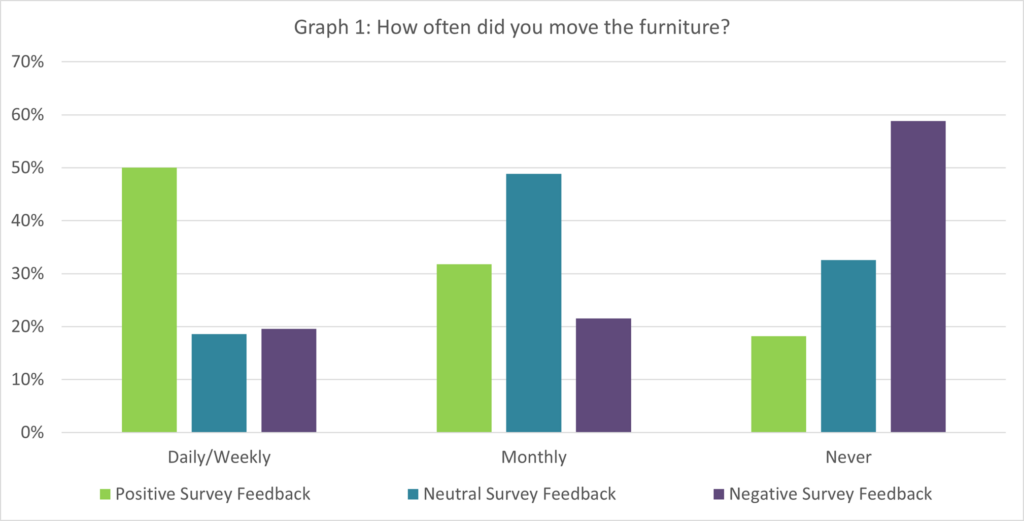
Looking at the data in Graph 1, the data gave us our answer. The data showed that the teachers who had responded negatively to earlier questions about the furniture and the district’s EdSpec goals had hardly moved the furniture within their classroom, if at all. On the other hand, teachers who had stated that they move the furniture weekly, or even daily, had an overwhelmingly positive response to their new NextGen furniture solutions. The negative data made it apparent to the team that the problems did not lie within the furniture itself, but instead with teachers’ unwillingness to adopt the new teaching modality options offered with the new furniture.
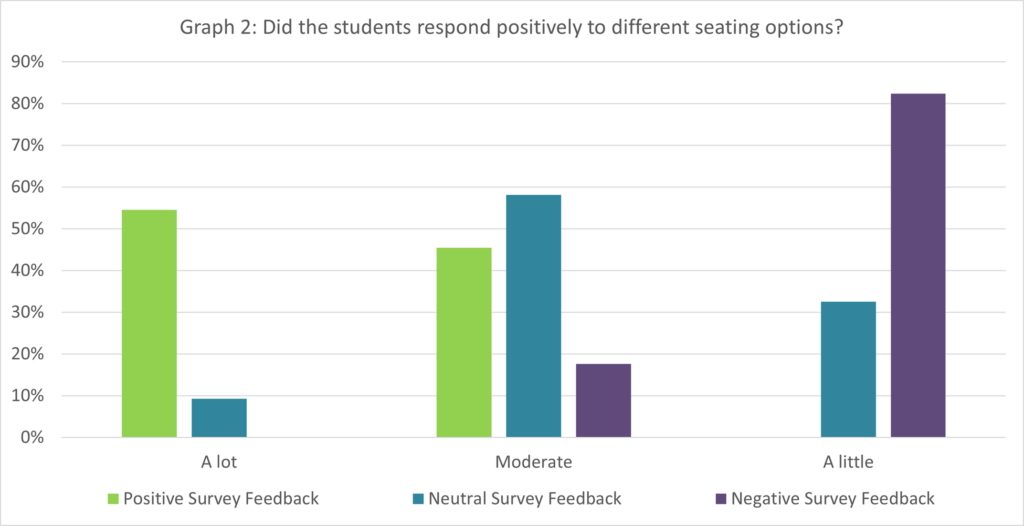
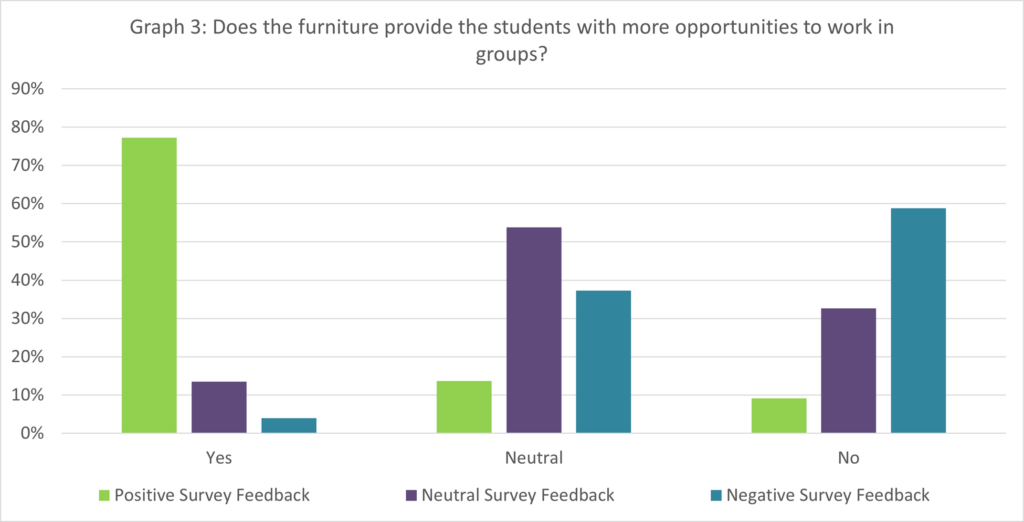
Teachers were also asked questions like, “Do the students respond positively to different seating options?” and “Do the students respond positively to different seating options?” As shown on graphs 2, 3, and 4, the data trends positively the more teachers participate in the flexibility of the NextGen furniture. These results indicate that the more teachers incorporated NextGen flexible furniture into their curriculum, the more positive the experience was for both teachers and students. Teachers who regularly engaged with the new furniture solutions also reported that they felt the new furniture helps achieve the district’s EdSpec goals. With the collaborative and interactive possibilities that these new tools bring to classrooms, one thing became clear to the team: movement matters.
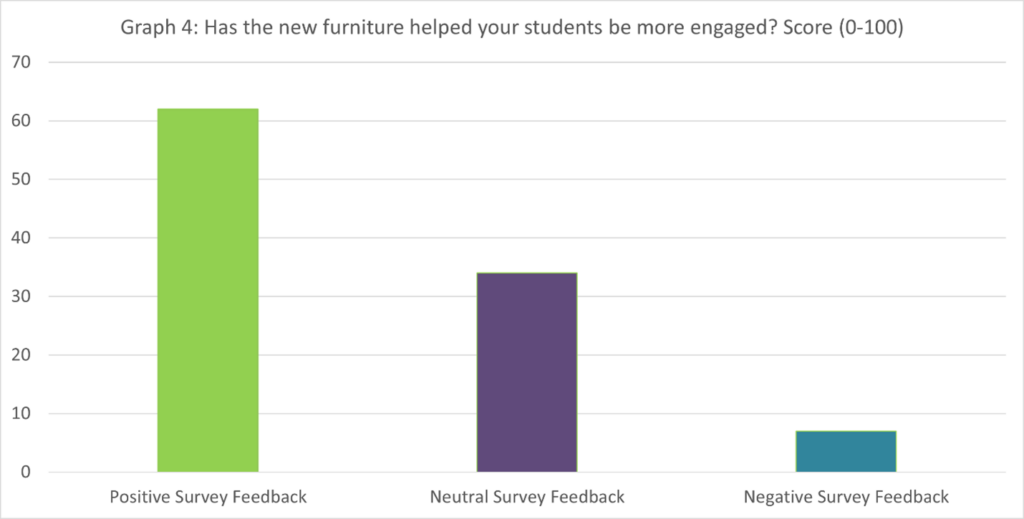
Conclusion
The data has caused many discussions among District leadership regarding the integration of the educational goals. It seems as if shifts toward NextGen practices is not reaching or being implemented by at least half of the teachers in the district. While this might be seen as a setback, the study presented data that confirmed how far the district still needs to evolve. This will prompt a greater push towards NextGen practices and additional professional development for the teachers.

